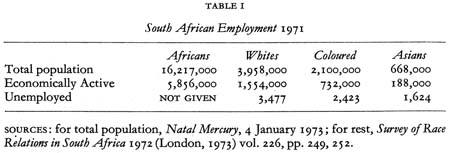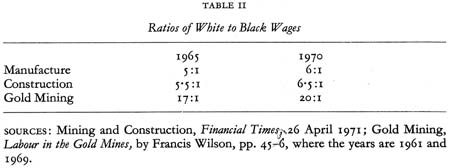The massive outbreak of black working-class resistance which hit South Africa and South West Africa in 1972 and 1973 was the reflection of structural changes which had been taking place in the settler economies and which have altered the context of the opposition movement. When South Africa left the gold standard in 1933, and even more when the post-1945 boom began, South Africa’s ruling class tried to break out of the country’s almost complete dependence on mining and agriculture. Although capitalist development in general, and foreign investment in particular, suffered setbacks in the aftermath of the Sharpeville shootings (March 1960), the process had been reversed by 1963–4, and this contributed, inter alia, to a further growth in the manufacturing sector. By the mid-1960s investment in the manufacturing sector had overtaken that in mining. Of the total private foreign investment in South Africa in 1968, an estimated 31 per cent went into the manufacturing sector. And by the middle of 1971 manufacturing alone accounted for 23·6 per cent of gnp—roughly equal to the contribution from mining and agriculture combined. footnote1
There were several reasons for this development of a manufacturing sector. One immediate concern was the need to employ the white poor, for whom mining and agriculture could not provide full employment.
footnote2
Recent figures indicate that the problem of the white poor and unemployed has been solved, at least officially:
The other major motivation was the need to substitute for South Africa’s imports of manufactured goods, and thereby to save foreign exchange. The actual net earning of foreign exchange through manufactured exports was a less central consideration. The predominantly domestic character of this growth was clear from the export figures: in 1971 manufacturing accounted for R534·2m out of a total volume of exports (excluding monetary gold) of R1,540m while imports ran at R2,877m—a striking index of the continued importance of monetary gold in the country’s trade. Even those manufactured goods that were exported went mainly to client states in southern Africa (Rhodesia, Lesotho, Botswana, Angola, Mozambique, South West Africa, Swaziland). The overwhelming majority of goods exported to the advanced capitalist countries remained agricultural and mining products. footnote3
With the fruits of this import substitution South Africa’s white population were able to enjoy a standard of living among the highest in the world, while the development of a domestic market for manufactured goods was restricted by the continued exclusion of the black population from access to these goods. However, despite the limited character of this process, it had the effect of encouraging the development of a black working class, situated in mining, urban services, and in manufacturing. By 1971, an estimated 6·8 million non-white workers, 5·9 million of them blacks, were to be found in these sectors. Yet this expansion collided with the apartheid policies of the Nationalist governments. During the J. G. Strijdom administration of 1954–8 a Senator Jan de Klerk piloted through parliament the Job Reservation Bill, a proposal that then became law and crowned decades of racist labour legislation. The function of this act was to reserve certain skilled and semi-skilled occupational categories for white workers. White unemployment was to be curtailed further in this way; and where no local whites were available, the needed whites were to be brought in by immigration. footnote4 Given the relatively low white birth rate in South Africa, this imported labour force was especially important.
Despite immigration, the expansion of manufacturing ran against the apartheid employment legislation. During the Verwoerd administration, 1958–66, leading industrialists campaigned for alteration of the industrial colour bar; and many industrialists went ahead with the training of black workers, a policy to which the government gave tacit consent. For fear of antagonizing the white electorate and the white trades unions, no public statements about this were made. Even this clandestine contravention was inadequate to meet the manufacturing sector’s demand for skilled and semi-skilled labour: with its high organic composition of capital, it needed a skilled proletariat, one which was not only familiar with the machinery in a minimal sense, but one which was able to operate the machinery. Capitalists wanted skilled and semi-skilled workers, and especially those who already had some experience of production in similar kinds of factories. The latter take far
A second important conflict created by apartheid was the restriction it placed on non-whites’ incomes. The black proletarians earned wages so low that they were restricted to necessities and this had important political consequences. The following picture of the ratios of white to black wages illustrates the difference:
In agriculture the distribution was even more uneven: the wages of black rural workers were, in real terms, below what they had been some 60 years before. footnote5 The conventional official formulation of this phenomenon is in terms of the Poverty Datum Line—the pdl. This is an index of the barest survival level: it omits family expenses for health, travel and education. Yet even this level has been forced to rise because of the inflationary situation that has been developing within the South African economy: while white workers have the vote and the legal trades union through which to influence the regime and raise their wages, the black working class has had no such outlet.

